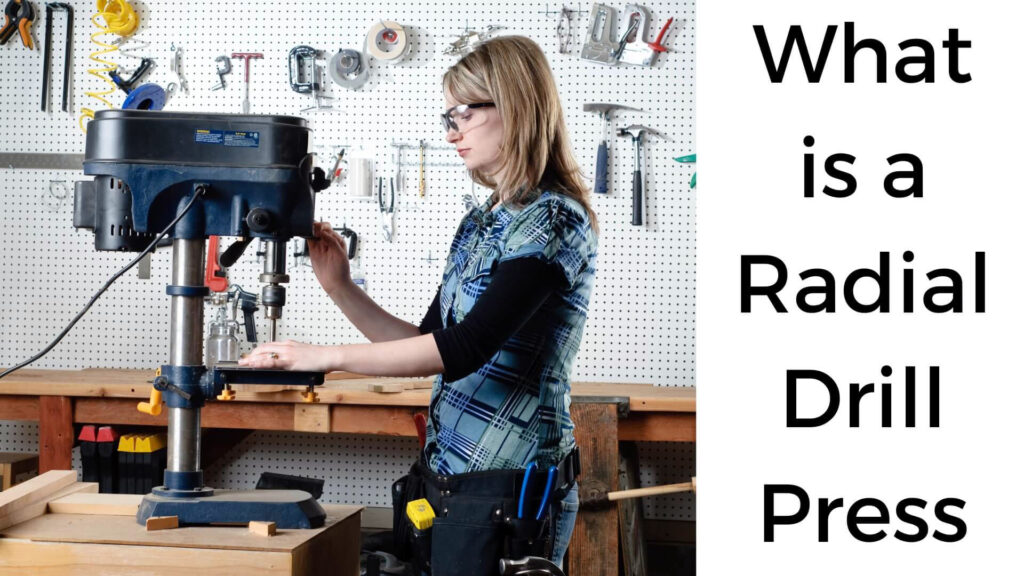When it comes to precision drilling in woodworking and metalworking, the radial drill press stands out as a versatile and effective tool. Designed for efficiency and accuracy, this machine is essential for many professional and industrial applications. In this blog post, we will delve into the intricacies of radial drill presses, discussing their design, features, applications, advantages, and how to choose the right one for your needs.
Table of Contents
Understanding the Radial Drill Press
A radial drill press, also known as a radial arm drill press, is a type of drilling machine that features an adjustable arm mounted on a vertical column. This unique design allows the drill head to move horizontally along the arm, enabling the user to drill holes at various angles and positions without moving the workpiece. The radial drill press is particularly useful for drilling large or heavy materials where repositioning would be cumbersome.
Key Components of a Radial Drill Press
- Base: The sturdy foundation that supports the entire structure. It often has mounting holes for securing the machine to the floor.
- Column: A vertical post that supports the arm and allows for height adjustments.
- Radial Arm: This adjustable arm extends out from the column and holds the drill head. Its length allows the user to move the drill head over a larger work area.
- Drill Head: Houses the motor, chuck, and drill bit. The drill head can be adjusted vertically and is often equipped with a depth stop for precise drilling.
- Table: A flat surface that supports the workpiece. The table can be adjusted vertically and may tilt for angled drilling.
- Chuck: The part that holds the drill bit in place. It can be manually tightened or loosened, or it may feature a quick-change mechanism for faster bit changes.
How Does a Radial Drill Press Work?
The operation of a radial drill press is relatively straightforward. Here’s a breakdown of its functionality:
- Positioning the Workpiece: The workpiece is placed on the adjustable table. Depending on the size and weight of the material, you may need to secure it using clamps.
- Adjusting the Arm: The radial arm can be moved horizontally along the column to position the drill head above the desired drilling location. This feature eliminates the need to reposition the workpiece for multiple holes.
- Setting the Drill Head: Once the drill head is in position, you can adjust its height and angle as needed. The drill head’s vertical movement is crucial for achieving the desired hole depth.
- Drilling: With the drill head positioned, you can activate the drill. The motor powers the drill bit, which penetrates the workpiece. The depth stop feature ensures consistent hole depth.
- Completion: Once the drilling is finished, you can retract the drill head and reposition it for further drilling or adjust the table for the next workpiece.
Advantages of a Radial Drill Press
Radial drill presses offer several advantages, making them a popular choice in various industries:
- Versatility: The adjustable arm allows for a wide range of drilling applications, from horizontal to vertical holes. This versatility is particularly useful for drilling large or awkwardly shaped materials.
- Precision: Radial drill presses provide greater accuracy in drilling compared to handheld drills. The fixed base and adjustable features ensure that holes are drilled precisely where needed.
- Ease of Use: Operating a radial drill press is relatively straightforward, making it accessible to both beginners and experienced users. The adjustments can be made quickly, allowing for efficient work.
- Safety: The design of a radial drill press minimizes the risk of accidents. The stationary nature of the machine means the operator is less likely to come into contact with moving parts compared to portable drills.
- Power: Radial drill presses are typically more powerful than handheld drills, allowing them to drill through tougher materials such as metals and dense hardwoods.
- Reduced Fatigue: Using a radial drill press reduces physical strain on the operator, as the machine does most of the work. This is especially beneficial when drilling multiple holes or working with heavy materials.
Applications of Radial Drill Presses
Radial drill presses are utilized across various industries and applications, including:
- Woodworking: Ideal for creating dowel holes, mortises, and other joinery tasks in woodworking projects.
- Metalworking: Commonly used in machine shops for drilling, tapping, and reaming holes in metal components.
- Construction: Helpful in creating holes for fasteners, anchors, and piping.
- Automotive: Used in manufacturing and repairing automotive parts, including drilling holes in frames and brackets.
- Masonry: Suitable for drilling into concrete or brick when equipped with the appropriate drill bits.
Types of Radial Drill Presses
Radial drill presses come in various sizes and configurations to accommodate different needs. Here are some common types:
1. Benchtop Radial Drill Press
- Description: Smaller and more compact, ideal for hobbyists and small workshops.
- Advantages: Space-saving design, suitable for lighter materials and tasks.
2. Floor-Mounted Radial Drill Press
- Description: Larger and more powerful, designed for industrial applications.
- Advantages: Greater stability and power, capable of handling heavier materials and larger drilling tasks.
3. Heavy-Duty Radial Drill Press
- Description: Designed for continuous use in industrial settings, built to withstand rigorous tasks.
- Advantages: High durability, precision, and enhanced features for advanced drilling applications.
Key Features to Look for When Buying a Radial Drill Press
When considering a radial drill press, several features can impact your purchasing decision:
- Power: Look for a motor with sufficient power (measured in horsepower) for your intended applications. More powerful motors can handle tougher materials.
- Adjustable Arm Length: Consider the reach of the radial arm. Longer arms provide more versatility for larger workpieces.
- Table Size and Adjustability: A larger, adjustable table allows for better support and positioning of various materials.
- Drill Speed Options: Multiple speed settings can enhance your drilling capabilities, allowing for different materials and bit sizes.
- Depth Stop Feature: A reliable depth stop is essential for consistent hole depth across multiple pieces.
- Construction Quality: Look for a sturdy build to ensure stability during operation, especially when drilling heavier materials.
- Safety Features: Ensure the drill press has safety features such as emergency stops and protective guards to minimize risks.
How to Use a Radial Drill Press Safely and Effectively
Operating a radial drill press requires attention to safety and best practices. Here are some guidelines:
- Read the Manual: Familiarize yourself with the specific model’s operating instructions and safety precautions.
- Wear Personal Protective Equipment (PPE): Always use appropriate PPE, including safety goggles, gloves, and hearing protection.
- Secure the Workpiece: Use clamps or vises to hold the workpiece securely in place to prevent movement during drilling.
- Check the Chuck: Ensure the drill bit is properly secured in the chuck before starting the drill.
- Adjust Settings: Before drilling, adjust the speed, depth stop, and table height according to your project requirements.
- Keep Hands Clear: Always keep your hands away from the drill bit while the machine is operating.
- Turn Off When Not in Use: Always turn off the machine and unplug it when changing bits or making adjustments.
- Regular Maintenance: Follow a regular maintenance schedule to keep the drill press in optimal condition.
1. What is the primary purpose of a radial drill press?
A radial drill press is primarily used for drilling holes in various materials, including wood, metal, and plastic. Its design allows for precision drilling at different angles and positions, making it ideal for complex drilling tasks.
2. How does a radial drill press differ from a standard drill press?
The key difference lies in the adjustable arm of the radial drill press, which allows the drill head to move horizontally along the arm, providing greater reach and versatility compared to a standard drill press, which typically has a fixed table and vertical movement only.
3. Can I use a radial drill press for milling tasks?
While a radial drill press is primarily designed for drilling, it can also perform light milling tasks when equipped with the appropriate tooling. However, it is not a substitute for a dedicated milling machine for more complex milling applications.
4. What size radial drill press do I need for my workshop?
The size of the radial drill press you need depends on the types of projects you plan to undertake. For smaller, hobbyist projects, a benchtop model may suffice. For larger, industrial tasks, a floor-mounted model with greater power and capacity would be more appropriate.
5. What materials can I drill with a radial drill press?
Radial drill presses are versatile and can be used to drill various materials, including wood, metal (aluminum, steel, etc.), plastics, and masonry when fitted with the right drill bits.
6. How do I maintain my radial drill press?
Regular maintenance includes cleaning the machine after use, lubricating moving parts, checking the belts and pulleys, ensuring the drill bits are sharp and properly secured, and inspecting electrical components for any signs of wear or damage.
Conclusion
A radial drill press is a versatile and powerful tool that enhances precision drilling in various applications, from woodworking to metalworking. Its unique design allows for flexibility and ease of use, making it a valuable addition to any workshop. By understanding its components, advantages, and proper usage, you can make informed decisions about how to incorporate a radial drill press into your projects.
Whether you’re a professional craftsman or a hobbyist, a radial drill press can significantly improve your drilling capabilities, enabling you to tackle more complex tasks with confidence. As you explore the world of drilling, remember to prioritize safety, maintenance, and the right features to ensure a successful and productive experience.

Hey, I am MD Hrithik Hossain, I’m a huge fan of DIY crafts. My workshop is where I spend most of my spare time, and I’m always working on some project. To that end, I’d like to share some of my knowledge and experience with you in power tools, woodworking, and other specialized materials fabrication.
I will guide you with genuine knowledge that can assist you with deciding whether a drill is appropriate according to your requirements or not. If you want to find the best drill and know which type of drill is most suited for your needs, then I can guide you with my expertise. My passion lies in helping others find the correct products they need at an affordable price.


